Li Xu
Microscopic Robots That Sense, Think, Act, and Compute
Mar 29, 2025Abstract:While miniaturization has been a goal in robotics for nearly 40 years, roboticists have struggled to access sub-millimeter dimensions without making sacrifices to on-board information processing due to the unique physics of the microscale. Consequently, microrobots often lack the key features that distinguish their macroscopic cousins from other machines, namely on-robot systems for decision making, sensing, feedback, and programmable computation. Here, we take up the challenge of building a microrobot comparable in size to a single-celled paramecium that can sense, think, and act using onboard systems for computation, sensing, memory, locomotion, and communication. Built massively in parallel with fully lithographic processing, these microrobots can execute digitally defined algorithms and autonomously change behavior in response to their surroundings. Combined, these results pave the way for general purpose microrobots that can be programmed many times in a simple setup, cost under $0.01 per machine, and work together to carry out tasks without supervision in uncertain environments.
Beyond Feature Mapping GAP: Integrating Real HDRTV Priors for Superior SDRTV-to-HDRTV Conversion
Nov 16, 2024



Abstract:The rise of HDR-WCG display devices has highlighted the need to convert SDRTV to HDRTV, as most video sources are still in SDR. Existing methods primarily focus on designing neural networks to learn a single-style mapping from SDRTV to HDRTV. However, the limited information in SDRTV and the diversity of styles in real-world conversions render this process an ill-posed problem, thereby constraining the performance and generalization of these methods. Inspired by generative approaches, we propose a novel method for SDRTV to HDRTV conversion guided by real HDRTV priors. Despite the limited information in SDRTV, introducing real HDRTV as reference priors significantly constrains the solution space of the originally high-dimensional ill-posed problem. This shift transforms the task from solving an unreferenced prediction problem to making a referenced selection, thereby markedly enhancing the accuracy and reliability of the conversion process. Specifically, our approach comprises two stages: the first stage employs a Vector Quantized Generative Adversarial Network to capture HDRTV priors, while the second stage matches these priors to the input SDRTV content to recover realistic HDRTV outputs. We evaluate our method on public datasets, demonstrating its effectiveness with significant improvements in both objective and subjective metrics across real and synthetic datasets.
An End-to-End Real-World Camera Imaging Pipeline
Nov 16, 2024



Abstract:Recent advances in neural camera imaging pipelines have demonstrated notable progress. Nevertheless, the real-world imaging pipeline still faces challenges including the lack of joint optimization in system components, computational redundancies, and optical distortions such as lens shading.In light of this, we propose an end-to-end camera imaging pipeline (RealCamNet) to enhance real-world camera imaging performance. Our methodology diverges from conventional, fragmented multi-stage image signal processing towards end-to-end architecture. This architecture facilitates joint optimization across the full pipeline and the restoration of coordinate-biased distortions. RealCamNet is designed for high-quality conversion from RAW to RGB and compact image compression. Specifically, we deeply analyze coordinate-dependent optical distortions, e.g., vignetting and dark shading, and design a novel Coordinate-Aware Distortion Restoration (CADR) module to restore coordinate-biased distortions. Furthermore, we propose a Coordinate-Independent Mapping Compression (CIMC) module to implement tone mapping and redundant information compression. Existing datasets suffer from misalignment and overly idealized conditions, making them inadequate for training real-world imaging pipelines. Therefore, we collected a real-world imaging dataset. Experiment results show that RealCamNet achieves the best rate-distortion performance with lower inference latency.
Diff-Tracker: Text-to-Image Diffusion Models are Unsupervised Trackers
Jul 11, 2024Abstract:We introduce Diff-Tracker, a novel approach for the challenging unsupervised visual tracking task leveraging the pre-trained text-to-image diffusion model. Our main idea is to leverage the rich knowledge encapsulated within the pre-trained diffusion model, such as the understanding of image semantics and structural information, to address unsupervised visual tracking. To this end, we design an initial prompt learner to enable the diffusion model to recognize the tracking target by learning a prompt representing the target. Furthermore, to facilitate dynamic adaptation of the prompt to the target's movements, we propose an online prompt updater. Extensive experiments on five benchmark datasets demonstrate the effectiveness of our proposed method, which also achieves state-of-the-art performance.
Active Learning Enabled Low-cost Cell Image Segmentation Using Bounding Box Annotation
May 02, 2024Abstract:Cell image segmentation is usually implemented using fully supervised deep learning methods, which heavily rely on extensive annotated training data. Yet, due to the complexity of cell morphology and the requirement for specialized knowledge, pixel-level annotation of cell images has become a highly labor-intensive task. To address the above problems, we propose an active learning framework for cell segmentation using bounding box annotations, which greatly reduces the data annotation cost of cell segmentation algorithms. First, we generate a box-supervised learning method (denoted as YOLO-SAM) by combining the YOLOv8 detector with the Segment Anything Model (SAM), which effectively reduces the complexity of data annotation. Furthermore, it is integrated into an active learning framework that employs the MC DropBlock method to train the segmentation model with fewer box-annotated samples. Extensive experiments demonstrate that our model saves more than ninety percent of data annotation time compared to mask-supervised deep learning methods.
Beyond Alignment: Blind Video Face Restoration via Parsing-Guided Temporal-Coherent Transformer
Apr 21, 2024



Abstract:Multiple complex degradations are coupled in low-quality video faces in the real world. Therefore, blind video face restoration is a highly challenging ill-posed problem, requiring not only hallucinating high-fidelity details but also enhancing temporal coherence across diverse pose variations. Restoring each frame independently in a naive manner inevitably introduces temporal incoherence and artifacts from pose changes and keypoint localization errors. To address this, we propose the first blind video face restoration approach with a novel parsing-guided temporal-coherent transformer (PGTFormer) without pre-alignment. PGTFormer leverages semantic parsing guidance to select optimal face priors for generating temporally coherent artifact-free results. Specifically, we pre-train a temporal-spatial vector quantized auto-encoder on high-quality video face datasets to extract expressive context-rich priors. Then, the temporal parse-guided codebook predictor (TPCP) restores faces in different poses based on face parsing context cues without performing face pre-alignment. This strategy reduces artifacts and mitigates jitter caused by cumulative errors from face pre-alignment. Finally, the temporal fidelity regulator (TFR) enhances fidelity through temporal feature interaction and improves video temporal consistency. Extensive experiments on face videos show that our method outperforms previous face restoration baselines. The code will be released on \href{https://github.com/kepengxu/PGTFormer}{https://github.com/kepengxu/PGTFormer}.
6D-Diff: A Keypoint Diffusion Framework for 6D Object Pose Estimation
Jan 02, 2024


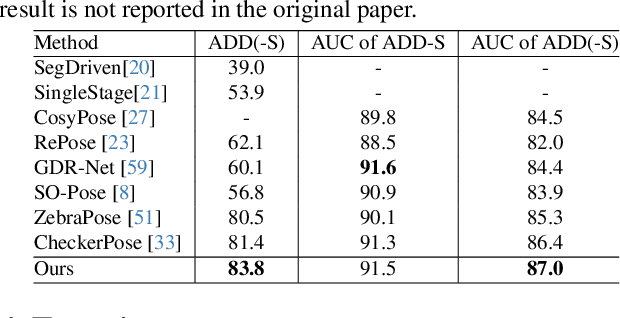
Abstract:Estimating the 6D object pose from a single RGB image often involves noise and indeterminacy due to challenges such as occlusions and cluttered backgrounds. Meanwhile, diffusion models have shown appealing performance in generating high-quality images from random noise with high indeterminacy through step-by-step denoising. Inspired by their denoising capability, we propose a novel diffusion-based framework (6D-Diff) to handle the noise and indeterminacy in object pose estimation for better performance. In our framework, to establish accurate 2D-3D correspondence, we formulate 2D keypoints detection as a reverse diffusion (denoising) process. To facilitate such a denoising process, we design a Mixture-of-Cauchy-based forward diffusion process and condition the reverse process on the object features. Extensive experiments on the LM-O and YCB-V datasets demonstrate the effectiveness of our framework.
Trustworthy Large Models in Vision: A Survey
Dec 01, 2023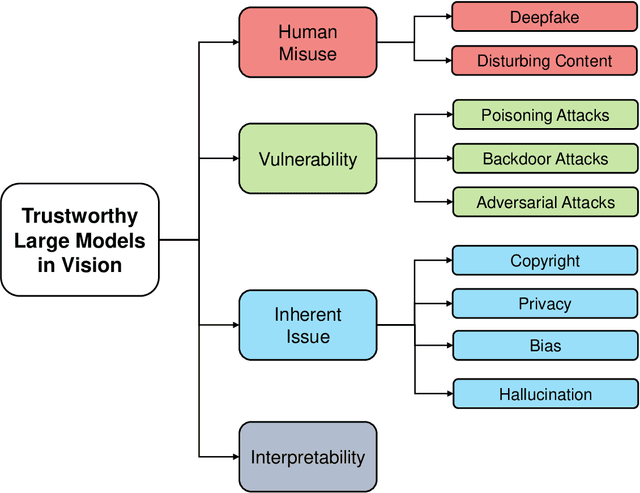

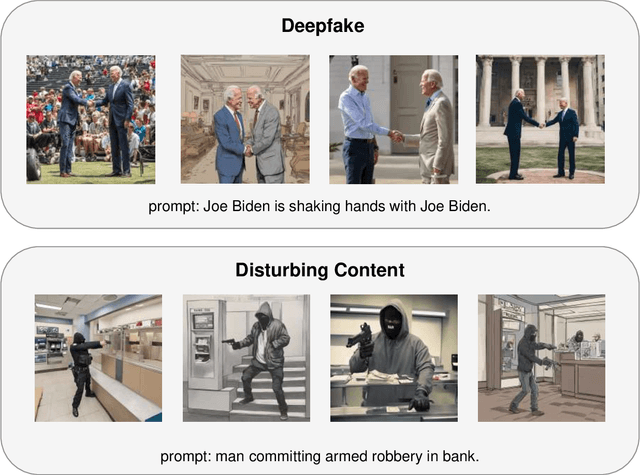
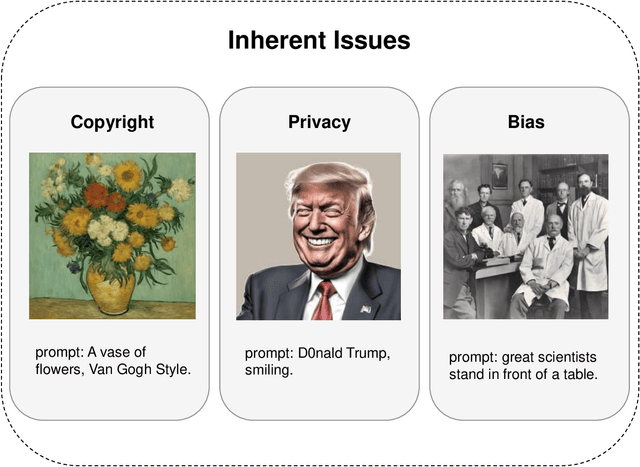
Abstract:The rapid progress of Large Models (LMs) has recently revolutionized various fields of deep learning with remarkable grades, ranging from Natural Language Processing (NLP) to Computer Vision (CV). However, LMs are increasingly challenged and criticized by academia and industry due to their powerful performance but untrustworthy behavior, which urgently needs to be alleviated by reliable methods. Despite the abundance of literature on trustworthy LMs in NLP, a systematic survey specifically delving into the trustworthiness of LMs in CV remains absent. In order to mitigate this gap, we summarize four relevant concerns that obstruct the trustworthy usage in vision of LMs in this survey, including 1) human misuse, 2) vulnerability, 3) inherent issue and 4) interpretability. By highlighting corresponding challenge, countermeasures, and discussion in each topic, we hope this survey will facilitate readers' understanding of this field, promote alignment of LMs with human expectations and enable trustworthy LMs to serve as welfare rather than disaster for human society.
Deep Neural Network Identification of Limnonectes Species and New Class Detection Using Image Data
Nov 15, 2023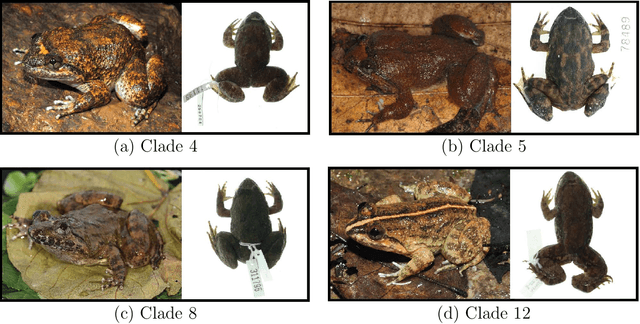



Abstract:As is true of many complex tasks, the work of discovering, describing, and understanding the diversity of life on Earth (viz., biological systematics and taxonomy) requires many tools. Some of this work can be accomplished as it has been done in the past, but some aspects present us with challenges which traditional knowledge and tools cannot adequately resolve. One such challenge is presented by species complexes in which the morphological similarities among the group members make it difficult to reliably identify known species and detect new ones. We address this challenge by developing new tools using the principles of machine learning to resolve two specific questions related to species complexes. The first question is formulated as a classification problem in statistics and machine learning and the second question is an out-of-distribution (OOD) detection problem. We apply these tools to a species complex comprising Southeast Asian stream frogs (Limnonectes kuhlii complex) and employ a morphological character (hind limb skin texture) traditionally treated qualitatively in a quantitative and objective manner. We demonstrate that deep neural networks can successfully automate the classification of an image into a known species group for which it has been trained. We further demonstrate that the algorithm can successfully classify an image into a new class if the image does not belong to the existing classes. Additionally, we use the larger MNIST dataset to test the performance of our OOD detection algorithm. We finish our paper with some concluding remarks regarding the application of these methods to species complexes and our efforts to document true biodiversity. This paper has online supplementary materials.
Intention-Aware Planner for Robust and Safe Aerial Tracking
Sep 16, 2023Abstract:The intention of the target can help us to estimate its future motion state more accurately. This paper proposes an intention-aware planner to enhance safety and robustness in aerial tracking applications. Firstly, we utilize the Mediapipe framework to estimate target's pose. A risk assessment function and a state observation function are designed to predict the target intention. Afterwards, an intention-driven hybrid A* method is proposed for target motion prediction, ensuring that the target's future positions align with its intention. Finally, an intention-aware optimization approach, in conjunction with particular penalty formulations, is designed to generate a spatial-temporal optimal trajectory. Benchmark comparisons validate the superior performance of our proposed methodology across diverse scenarios. This is attributed to the integration of the target intention into the planner through coupled formulations.
 Add to Chrome
Add to Chrome Add to Firefox
Add to Firefox Add to Edge
Add to Edge